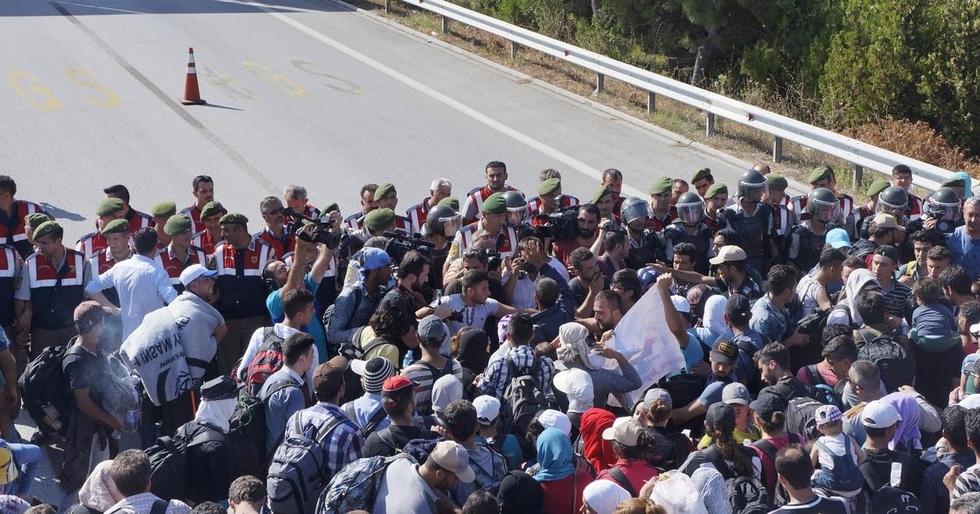Where is America's response to the Middle East refugee crisis?

A searing image of a refugee child lying dead on a beach finally alerted the world to a crisis now entering its fifth year. Awareness is never bad, but here it too easily bypasses the question of where all the refugees come from, in favour of a simpler meme. One is reminded of Malala, one story that pushes aside millions.
Such narratives bait a familiar trap: the need to “do something”. That “something” in the Middle East is often the clumsy hand of military intervention under the thin cover of humanitarian rhetoric. Cries answered that way have a terrible history of exacerbating a problem they ostensibly set out to solve.
The scope of the problem is staggering. According to the United Nations High Commission for Refugees, there are more than three million Syrian refugees in the Middle East. Inside Syria itself, over 17 million people are in need of humanitarian assistance, including those internally displaced. Only 350,000 Syrians are estimated to have travelled to Europe. They are the ones you see on television.
In Iraq, some 1.8 million people were displaced between January and September 2014, a declared United Nations emergency, and Iraqis are currently the second-largest refugee group in the world. Yet even now the New York Times speaks of a "new wave" of Iraqi refugees, driven in part by "years of violence and unmet promises for democracy by a corrupt political elite".
The situation in Libya, Yemen, Afghanistan, Somalia and elsewhere is much the same.
There is a common denominator behind all of these refugee flows: they are, in whole or in part, the product of American "humanitarian interventions".
In 2003, President George W. Bush declared the goals of the United States in invading Iraq included freeing its people. In case that was not clear enough, in 2007 Bush proclaimed the American military the "greatest force for human liberation the world has ever known". Yet by 2007 the number of displaced persons in Iraq had grown by some 50 percent.
President Barack Obama used similar rhetoric in 2014, when he revived the United States' war in Iraq in response to a "humanitarian crisis that could turn into a genocide" for the Yazidi people. “One Iraqi cried that there is no one coming to help,” President Obama said at the time. “Well, today America is coming to help.” A senior administration official went on to explicitly describe the action as a humanitarian effort.
Some 5,000 airstrikes later, that humanitarian effort is now a bloody war with Islamic State, metastasized across multiple nations, exacerbating the refugee flow. For the Yazidis, long-forgotten by Americans as the no longer needed casus belli, the war enveloped them in Islamic State's slave trade.
The conflict in Syria remains connected to the 2003 American invasion of Iraq, in the form of militarised Sunni militias which took up arms, the growth of al-Qaeda and its off-shoots in Iraq, and of course the birth of Islamic State. Add to that the elimination of any effective border between Iraq and Syria to allow those forces to flow freely back and forth. American intervention in Syria ratcheted up seemingly on a schedule, all around the theme of saving the Syrian people from their dictator, Bashar al-Assad (similarities to George W Bush's 2003 wording in reference to Saddam Hussein are noted).
After it appeared Assad used chemical weapons in 2013, it was American Secretary of State John Kerry who insisted that it was “not the time to be silent spectators to slaughter”. Airstrikes were forestalled for a time, then popped up in 2014 aimed not at Assad, but at Islamic State. Chaos has gone on to drawn numerous foreign powers into the conflict.
With Libya in 2011, there was again a "humanitarian effort," led by then-Secretary of State Hillary Clinton. Clinton sold intervention as a necessity: “Imagine we were sitting here and Benghazi had been overrun, a city of 700,000 people, and tens of thousands of people had been slaughtered, hundreds of thousands had fled. The cries would be, ‘Why did the United States not do anything?’” That “doing something” helped push Libya into failed state status, feeding the refugee flow and bleeding conflict into neighbouring countries.
It is foolish to claim the United States alone "caused" all of these refugee flows; multiple factors, including the aggressiveness of Islamic State, are in play. But it would be equally foolish to ignore American culpability, directly in Iraq and in Libya, and via arms flows and the fanning of flames, in Syria and Yemen. The common element is a stated intent to make things better. The common result is the opposite.
To many, particularly outside the United States, political rhetoric is just the aural garbage of imperialism. But inside the United States, military “humanitarian” intervention generally enjoys robust support. It may look like a shoddy product to some, but people continue to buy it, and thus it continues to happen. Politicians seem to know how to feed the public's demands to “do something” triggered by an emotional photograph for their own purposes.
There exists an inverse relationship between those that create refugees and those who help them. The United Nations High Commission for Refugees referred 15,000 Syrians to Washington for resettlement over the last four years; the United States accepted only 1,500, citing, among other issues, concerns over terrorists hiding among the groups.
But that was then, pre-photo.
Post-photo, with no apparent irony, United States Senator Patrick Leahy stated the refugee crisis “warrants a response commensurate with our nation’s role as a humanitarian leader”. Secretary of State John Kerry said the United States is “looking hard at the number” of additional Syrian refugees it might accommodate, given America's “leadership role with respect to humanitarian issues and particularly refugees”.
Right on schedule following Kerry's remarks, President Obama promised, per the New York Times headline, to "Increase Number of Syrian Refugees for US Resettlement to 10,000." With the problem seemingly solved, albeit only 10,000 out of millions, the plight of the refugees disappeared from America's front pages.
Left unsaid was the emptiness of even such non-military humanitarian rhetoric. President Obama did not mention, nor was he asked about, the reality that refugees to the US are processed, not accepted. That processing can take years (the average out of Syria is two years at present), indefinite if enough information on a person's security background cannot be amassed. If a positive "up" decision cannot be made that a person is "safe," then the default is indefinite pending status. Such a conundrum has, for example, stymied the applications of many Iraqis and Afghanis who served as translators for the American military and fear for their lives, only to have been left behind.
There also remain voices calling for another escalation of war in the Middle East to deal with the “root causes” of the refugee crisis, loosely defined for now as Islamic State's continued existence.
There is an immediate need to do more to help the refugees moving into Europe, and those still in the Middle East. That, and that alone, should comprise the “do something” part of a solution. Long term, if the primary response is simply more military intervention in the name of humanitarianism, or more empty promises, the answer is best left as “doing less”.
- Peter Van Buren is a retired 24-year veteran of the US Department of State, including service in Iraq. He is the author of We Meant Well: How I Helped Lose the Battle for the Hearts and Minds of the Iraqi People. His latest book is Ghosts of Tom Joad: A Story of the 99 Percent. He lives and writes from New York City.
The views expressed in this article belong to the author and do not necessarily reflect the editorial policy of Middle East Eye.
Photo: Refugees who want to go to Europe walk towards the Edirne city centre, Turkey on September 18, 2015. (AA)
New MEE newsletter: Jerusalem Dispatch
Sign up to get the latest insights and analysis on Israel-Palestine, alongside Turkey Unpacked and other MEE newsletters
Middle East Eye delivers independent and unrivalled coverage and analysis of the Middle East, North Africa and beyond. To learn more about republishing this content and the associated fees, please fill out this form. More about MEE can be found here.





